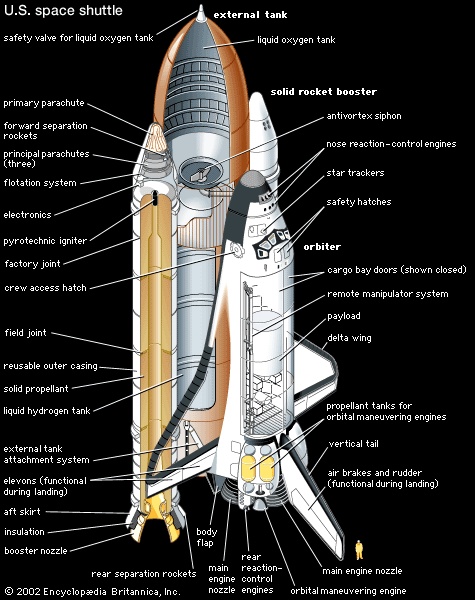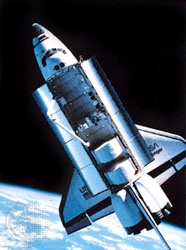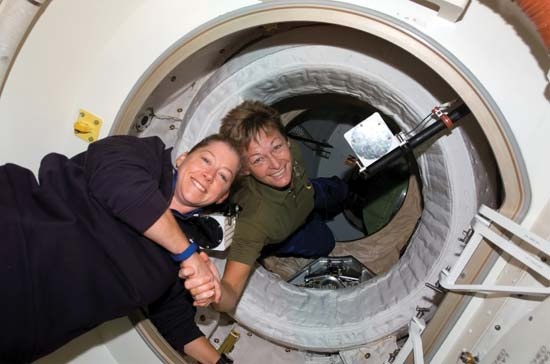space shuttle
partially reusable rocket-launched vehicle designed to go into orbit around Earth, to transport people and cargo to and from orbiting spacecraft, and to glide to a runway landing on its return to Earth's surface. The first vehicle of this type was developed by the U.S. National Aeronautics and Space Administration (NASA). Formally called the Space Transportation System (STS), it lifted off into space for the first time on April 12, 1981.
 The U.S. space shuttle consists of three major components: a winged orbiter that carries both crew and cargo; an external tank containing liquid hydrogen (fuel) and liquid oxygen (oxidizer) for the orbiter's three main rocket engines; and a pair of large, solid-propellant, strap-on booster rockets. At liftoff the entire system weighs 2 million kilograms (4.4 million pounds) and stands 56 metres (184 feet) high. During launch the boosters and the orbiter's main engines fire together, producing about 31,000 kilonewtons (7 million pounds) of thrust. The boosters are jettisoned about two minutes after liftoff and are returned to Earth by parachute for reuse. After attaining 99 percent of its orbital velocity, the orbiter has exhausted the propellants in the external tank. It releases the tank, which disintegrates on reentering the atmosphere. Although the orbiter lifts off vertically like an expendable rocket launcher, it makes an unpowered descent and landing similar to a glider.
The U.S. space shuttle consists of three major components: a winged orbiter that carries both crew and cargo; an external tank containing liquid hydrogen (fuel) and liquid oxygen (oxidizer) for the orbiter's three main rocket engines; and a pair of large, solid-propellant, strap-on booster rockets. At liftoff the entire system weighs 2 million kilograms (4.4 million pounds) and stands 56 metres (184 feet) high. During launch the boosters and the orbiter's main engines fire together, producing about 31,000 kilonewtons (7 million pounds) of thrust. The boosters are jettisoned about two minutes after liftoff and are returned to Earth by parachute for reuse. After attaining 99 percent of its orbital velocity, the orbiter has exhausted the propellants in the external tank. It releases the tank, which disintegrates on reentering the atmosphere. Although the orbiter lifts off vertically like an expendable rocket launcher, it makes an unpowered descent and landing similar to a glider.
 The space shuttle can transport satellites and other craft in the orbiter's cargo bay for deployment in space. It also can rendezvous with orbiting spacecraft to allow astronauts to service, resupply, or board them or to retrieve them for return to Earth. Moreover, the orbiter can serve as a space platform for conducting experiments and making observations of Earth and cosmic objects for as long as about two weeks. On some missions it has carried a European-built pressurized facility called Spacelab, in which shuttle crew members have conducted biological and physical research in weightless conditions.
The space shuttle can transport satellites and other craft in the orbiter's cargo bay for deployment in space. It also can rendezvous with orbiting spacecraft to allow astronauts to service, resupply, or board them or to retrieve them for return to Earth. Moreover, the orbiter can serve as a space platform for conducting experiments and making observations of Earth and cosmic objects for as long as about two weeks. On some missions it has carried a European-built pressurized facility called Spacelab, in which shuttle crew members have conducted biological and physical research in weightless conditions.Designed to be reflown as many as 100 times, the U.S. space shuttle originally had been expected to reduce the high cost of spaceflight into low Earth orbit. After the system became operational, however, the vehicle's operating costs and the time needed for refurbishment between flights proved to be significantly higher than early projections. Between 1981 and 1985 a fleet of four orbiters—Columbia (the first to fly in space), Challenger, Discovery, and Atlantis—was put into service. On January 28, 1986, Challenger, carrying seven astronauts, exploded shortly after liftoff, killing all aboard including a private citizen, schoolteacher Christa McAuliffe (McAuliffe, Christa Corrigan). (See disaster (Challenger disaster).) The presidential commission appointed to investigate the accident determined that a joint seal in one of the solid rocket boosters had failed as a result of mechanical design problems, which were exacerbated by the unusually cold weather on the morning of the launch. Hot gases leaking from the joint eventually ignited the fuel in the shuttle's external tank, causing the explosion. After the accident, the shuttle fleet was grounded until September 1988 to allow NASA to correct the design flaws and implement associated administrative changes in the shuttle program. In 1992, Endeavour, a replacement orbiter for the destroyed Challenger, flew its first mission. NASA has announced that the space shuttle program will end in 2010 and that subsequent manned missions will use a vehicle called Orion, which will be similar to the Apollo spacecraft.
 Between 1995 and 1998, NASA conducted a series of shuttle missions to the orbiting Russian space station Mir to give the agency experience in station operations in anticipation of the construction of the modular International Space Station (ISS). Beginning in 1998, the shuttle was used extensively to take components of the ISS into orbit for assembly and to ferry astronaut crews and supplies to and from the station.
Between 1995 and 1998, NASA conducted a series of shuttle missions to the orbiting Russian space station Mir to give the agency experience in station operations in anticipation of the construction of the modular International Space Station (ISS). Beginning in 1998, the shuttle was used extensively to take components of the ISS into orbit for assembly and to ferry astronaut crews and supplies to and from the station.On February 1, 2003, Columbia broke up catastrophically over north-central Texas at an altitude of about 60 km (40 miles) as it was returning from an orbital mission. All seven crew members died, including Ilan Ramon, the first Israeli astronaut to go into space. (See disaster (Columbia disaster).) Once again the shuttle fleet was immediately grounded. The accident investigation board concluded that, during the launch of the shuttle, a piece of insulating foam had torn from the external tank and struck the orbiter's left wing, weakening its thermal protection ability. When the orbiter later reentered the atmosphere, it was unable to withstand the superheated air, which penetrated the wing and destroyed it, leading to the vehicle's breakup. As in the analysis of the Challenger disaster, the Columbia accident was seen as the result of both mechanical and organizational causes that needed to be addressed before shuttle flights could resume. (For additional information on the space shuttle, see space exploration.)
- scapolite
- scapula
- scar
- scarab
- scarab beetle
- Scaramouche
- Scarborough
- scarecrow
- Scarfe, Gerald
- scarification
- Scarlatti, Alessandro
- Scarlatti, Domenico
- scarlet fever
- scarlet snake
- Scarron, Paul
- Scarsdale
- scat
- scatologia
- scattering
- scaup
- Scaurus, Marcus Aemilius
- scavenger
- Sceaux ware
- Scelba, Mario
- scenario